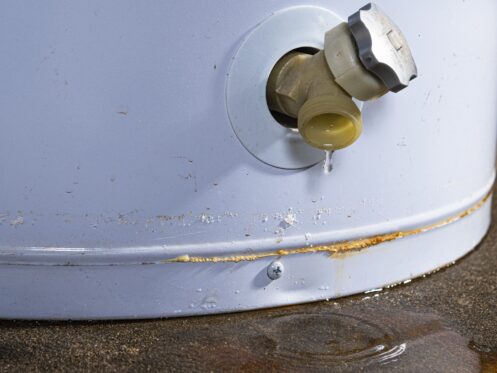Replacing the water heater in your Stroudsburg, PA home before it reaches the end of its lifespan could spare you a lot of extra and unnecessary spending and stress. While some water heaters last just eight to 10 years, others have service lives that span 20 years or more. One sure sign that it’s time to have this appliance thoroughly maintained or swapped out is fast-mounting pressure. Fortunately, you can prevent pressure-related tank ruptures, leaks, and explosions by finding and using your water heater’s pressure relief valve. Read on to find out how.
What a Pressure Relief Valve Is
Also known as a temperature/pressure relief valve or TPR, the pressure relief valve on your water heater is a built-in safety feature for releasing excess heat and steam. On newer water heaters, these valves open up automatically whenever internal pressure rises above 150 pounds per square inch (psi) or internal temperatures exceed 210 degrees Fahrenheit. For reference, the ideal pressure level in a water heater’s tank is between just 50 and 100 psi.
TPR valves are typically located at the top of water heater tanks. However, on some models, TPR valves are installed on the upper sides of tanks where they connect to copper pipes that travel the length of water heaters.
On some water heaters, pressure relief valves must be opened manually. This is done by lifting the valve up until its brass stem is raised and water is released. Whether your water heater’s TPR valve opens on its own or is opened by you, expect a sudden rush of hot water that leaves a small puddle or pool just around the base of the appliance. Although these messes are frequently mistaken for the signs of leaky or ruptured water heater tanks, they simply mean that pressure relief valves are doing their jobs.
Tips for Locating the TPR
Among the best ways to find your water heater’s TPR is by referring to your owner’s manual. You can always visit the website of your water heater manufacturer to download a copy of your owner’s manual if you can’t find this booklet. Many product manufacturers offer downloadable manuals, TPR troubleshooting tips, and in-depth video tutorials on using these important safety features.
However, all water heaters require professional service every year. Scheduling tune-up service to have preventative components like sacrificial anode rods replaced and your water heater flushed out will reduce the risk of problems that cause elevated pressure. These appointments also give plumbers the chance to show homeowners where TPR valves are, how to use them, and when to use them.
When showing you where your water heater’s pressure relief valve is, we can also tell you whether you have a manual TPR valve or an automatic one. If an automatic TPR valve never engages on its own when temperature or pressure levels rise too high, it’s likely because this feature is broken or malfunctioning.
An automatic TPR valve might fail to open in the following instances:
- Dirt or sediment blocking its relief port
- Severely corroded relief port
- Defective valve
- Stuck valve
To ensure that TPR problems are never overlooked for long, you should test this valve every six to 12 months or have it tested by a licensed plumber during routine water heater maintenance.
What Causes Pressure to Build in Water Heaters?
Dramatic increases in in-tank pressure are usually the result of built-up sediment and corrosion. However, it’s also possible to trigger a rise in pressure by simply setting your water heater’s temperature too high. To prevent scalding accidents and internal tank damage, homeowners are advised to never raise their water heaters’ temperature settings above 120 degrees Fahrenheit.
What Can Happen If the Pressure Relieve Valve Doesn’t Open?
Mounting pressure in a storage-based water heater must be released. If it cannot escape via the pressure relief valve, it will eventually exit via the tank’s weakest point. Just as build-ups of sediment and corrosion affect the functionality of TPR valves, they also undermine the integrity of glass tank liners and turn exposed tank materials into powdery, rust-colored dust. Wherever tank corrosion is most severe, hot steam and water will find a way out. This is a common cause of tank ruptures and major tank leaks.
Although water heater explosions aren’t common, they can and do occur. Moreover, they’re often the result of failed TPR valves. These events aren’t like tank ruptures that spew massive amounts of water onto the floor until tanks run dry. Instead, they can propel water heaters across rooms and cause serious building damage and physical harm in the process. The best way to prevent a water heater tank explosion is to have this appliance and its safety features tested annually.
We’re proud to serve Stroudsburg, PA and the surrounding communities. We offer top-notch heating, cooling, and plumbing services. We also install, maintain, and repair tankless and storage-based water heaters. To schedule an appointment, contact R.J. Groner Inc. today.






